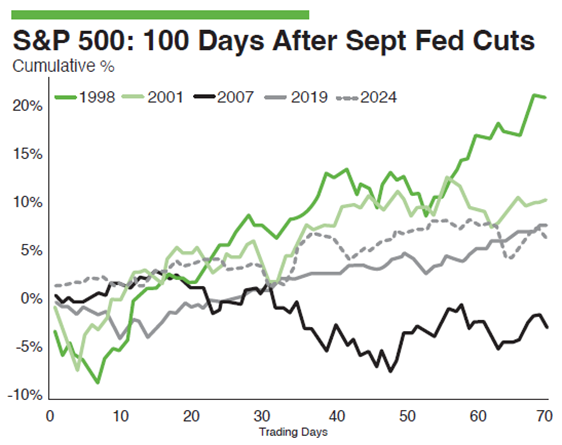Editor’s note: It’s day 2 of the latest government shutdown.
But your attention should be laser-focused on the Federal Reserve System, which continues to operate.
The nation’s central bank is between two of its most important meetings of the year.
Last month, it cut interest rates for the first time this year.
After its Oct. 29 meeting, it is set to make another quarter-point cut.
Whether the government stays shuttered for three days or 35 days, which it did under the previous Trump administration, is not yet clear.
What we do know is that every time the Fed pivots, your portfolio needs to be prepared for the impact.
For what the next cut might mean for you, we asked Mark Gough.
Mark’s a seasoned market analyst with over 15 years navigating equities, commodities and cryptos.
He’s seen plenty of rate cycles. And he just told us this one may be different than what you’re used to … which means the way you prepared in the past might not work this time.
Here’s how to prepare not just for Oct. 29, but a key date that Juan Villaverde’s timing model flagged right in front of it.
In fact, get ahead of both by attending a special event on Tuesday, Oct. 7, at 2 p.m. Eastern.
Juan will be unveiling something big ahead of these key dates. And it comes with a big prediction.
I’ll give you a hint: It looks like a big buying opportunity for a small group of assets.
 |
| By Mark Gough |
Last month, the Fed trimmed its benchmark rate by a quarter-point, or 25 basis points.
For cryptos, this is a supportive step … but not the kind of dramatic policy shift that ignites runaway rallies.
Just look at past rate cuts:
Over the past 25 years, the S&P 500 has gained an average of 8.5% in the 100 trading days following a September cut.
But the paths have been anything but uniform …
- 1998 (Long-Term Capital Management crisis): A 25-bps cut restored confidence after a major hedge fund collapse threatened global markets. Stocks surged 21% in 100 days.
- 2001 (post-9/11): An emergency 50-bps cut helped spark a rebound. But structural weakness capped gains at 10.7%.
- 2007 (housing crisis): A 25-bps cut came too late. Within 100 days, the S&P was down 2.9%, foreshadowing the Great Recession.
- 2019 (trade tensions): A modest “insurance” cut steadied markets, producing a 7.8% gain.
- 2024 (inflation easing): A surprise 50-bps cut delivered a 6.3% gain, but stocks were already near highs, which limited enthusiasm.
The lesson is clear:
- Cuts delivered during crises tend to spark the biggest rallies,
- Normalization cuts provide a gentler tailwind
- And recession-onset cuts rarely help much at all.
This Time Could Be Different
What makes this cut especially interesting is the backdrop.
This isn’t 1998, when the Fed rescued markets from a hedge fund collapse. It’s not 2007 either, when the recession was already setting in.
That means this is a “normalization” cut. So, we should expect modest momentum.
Still, the timing is delicate.
The labor market has softened in recent months, giving the Fed cover to ease policy. However, core inflation remains above the Fed’s 2% target, limiting its aggression.
On top of that, equities are already trading near cycle highs. This matters because history shows that, when stocks are priced for perfection, cuts tend to have a more muted effect.
This combination makes this latest Fed cut closer to 2019 or 2024 — cuts designed to sustain momentum, not revive it.
But there’s another asset to keep your eye on: stablecoins.
These digital dollars have exploded in popularity and utility this bull cycle. They now act as the plumbing of crypto markets.
When interest rates fall, the appeal of holding yield-bearing Treasury notes diminishes … and capital rotates back into stablecoins.
Once that happens, that liquidity often finds its way into higher-risk assets.
And right now in 2025, after months of stagnation, stablecoin supply is beginning to expand again. That’s one of the clearest signals that liquidity is on the move.
No Matter What, Cuts Hit Crypto Harder
Equities often respond to Fed cuts with measured, modest moves. Crypto is another story entirely.
Bitcoin has historically acted as a liquidity barometer. When liquidity expands, it tends to move first, though not always in a straight line.
In 2019, Bitcoin declined during the easing cycle because it had already exploded higher earlier that year. It ran from $3,000 to $13,000 before the Fed even acted.
By contrast, in 2024, Bitcoin behaved more like a traditional risk asset. As the Fed began normalizing policy, Bitcoin rallied alongside stocks, leading the risk-on move.
Altcoins take things a step further.
They behave like high-growth tech stocks in the late ’90s — higher risk, more volatility and greater potential reward.
Once liquidity flows, altcoins often outperform Bitcoin. That’s why popular narratives within crypto can rally so explosively during easing cycles.
In addition, crypto is now deeply integrated into the financial system.
Unlike in past cycles, institutional adoption is far more advanced, with ETFs, custody solutions and even corporate treasuries holding crypto.
Liquidity no longer leaks into the space — it floods in through structured channels.
In addition, the narratives driving crypto are broader than ever. Real-world assets, AI tokens and Solana’s DeFi ecosystem are just some sectors waiting for fresh liquidity to accelerate.
This wasn’t the case in 2019 or even 2021, when Bitcoin and Ethereum were the main drivers.
Today, crypto is bigger. More diverse. And more interconnected with global markets.
As a crypto investor, the message to take away is straightforward: The Fed’s actions will impact the crypto market … and your portfolio.
Historically, crypto markets have been some of the biggest beneficiaries when the Fed opens the floodgates.
Which means the recent cut could mark the start of the next chapter in this cycle.
But to really take advantage, you’ll need to get in at the right time.
That makes next Tuesday’s unveiling so timely.
Juan Villaverde, our crypto and cycles analyst, is set to show off his brand-new Timing Model 2.0.
This is a big deal. It was built with advanced AI and has the power to generate AVERAGE gains of 6,630% for each crypto asset.
And it just signaled a key date to watch later this month.
You’ll want a seat at the table when Juan shares it for the first time on Tuesday, Oct. 7, at 2 p.m. Eastern.
Best,
Mark Gough


